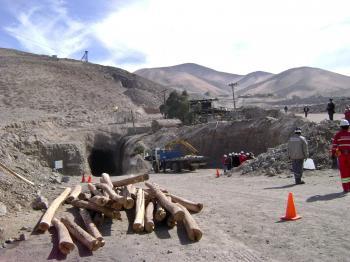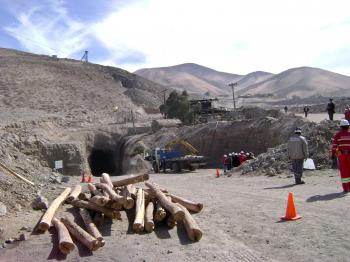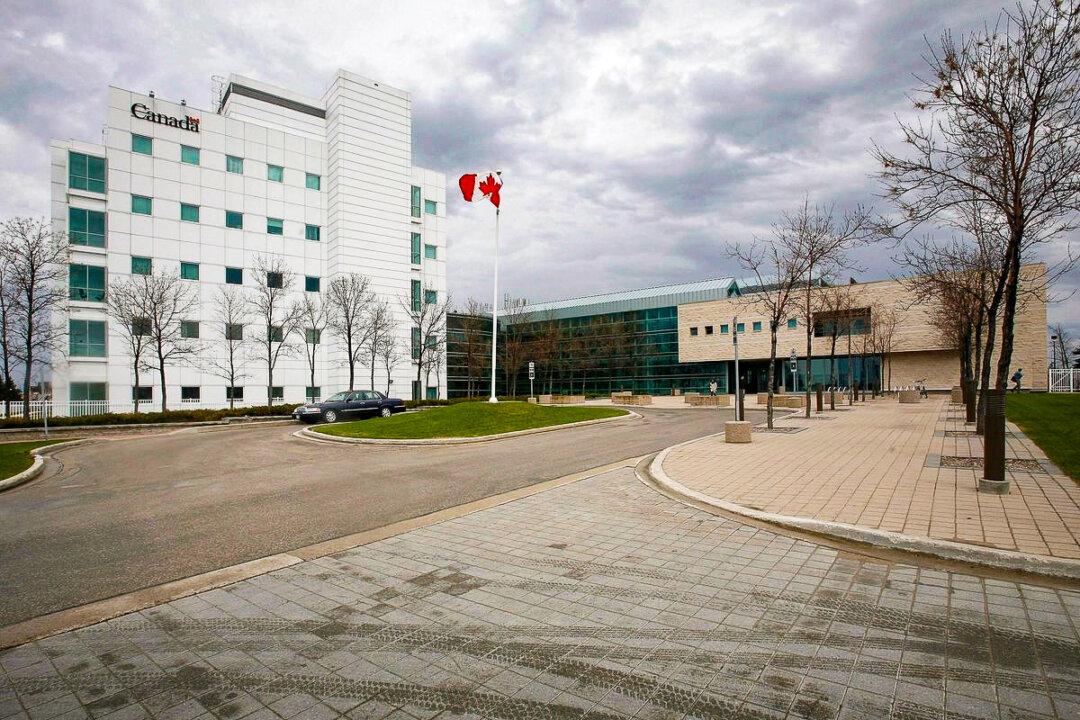If Mario Gomez, the oldest of the 33 men trapped in the Chile mine for over two months, could have it his way, his grandchildren will never enter a mine.
The 63-year old urged his grandchildren to “study a profession” instead after making it to the surface, Reuters reported.
Shortly after the incident, Chilean president Sebastian Pinera vowed “never again in our country will we permit people to work in conditions so unsafe and inhuman as they worked in the San Jose Mine, and in many other places in our country.”
On Monday, nearly two weeks after the rescue, the miners visited Pinera at the presidential palace and took to the field against government officials in a friendly soccer game full of photo ops. The day in the limelight stood in sharp contrast to their dark ordeal, but their plight may be ushering in a new era in worker safety for Chile.
The 63-year old urged his grandchildren to “study a profession” instead after making it to the surface, Reuters reported.
Shortly after the incident, Chilean president Sebastian Pinera vowed “never again in our country will we permit people to work in conditions so unsafe and inhuman as they worked in the San Jose Mine, and in many other places in our country.”
On Monday, nearly two weeks after the rescue, the miners visited Pinera at the presidential palace and took to the field against government officials in a friendly soccer game full of photo ops. The day in the limelight stood in sharp contrast to their dark ordeal, but their plight may be ushering in a new era in worker safety for Chile.
Poor Safety Record
The miners in the San Jose gold and copper mine near Copiapo in Northern Chile were trapped after the entrance to the mine was blocked by a landslide. They survived on a very limited supply of food and water for 17 days before making contact with the outside world, and were eventually pulled to safety after enduring 69 days underground.
The horrific incident that trapped the 33 miners 2,300 feet below ground put another black mark on Chile’s worker safety record. It prompted Chilean President Sebastian Pinera to vow to revamp the nation’s work safety regulations and set up a commission to recommend ways to improve workplace conditions.
For its part, Chile’s mining safety record has come a long way. With 35 deaths from mining incidents last year, the mining fatality record of the South American nation is much closer to the United States with 34 fatalities. China by contrast, known as having deplorably safety conditions at mines and other large-scale industrial sites, had 2,631 officially-reported mining deaths in 2009.
But questions have been raised as to why the country only has 18 inspectors for the hundreds of mines in the resource-rich nation, or why the San Jose mine was operating despite known safety concerns.
The rate of mining accidents leading to disability in Chile is 4.03 per million hours/person and the fatality rate is 0.10 per million hours/person, according to Sernagemoin, Chile’s National Geology and Mining Service. In 2009, there were 1,391 accidents leading to disability, and 35 fatalities. So far in 2010 there have been 31 fatalities.
The horrific incident that trapped the 33 miners 2,300 feet below ground put another black mark on Chile’s worker safety record. It prompted Chilean President Sebastian Pinera to vow to revamp the nation’s work safety regulations and set up a commission to recommend ways to improve workplace conditions.
For its part, Chile’s mining safety record has come a long way. With 35 deaths from mining incidents last year, the mining fatality record of the South American nation is much closer to the United States with 34 fatalities. China by contrast, known as having deplorably safety conditions at mines and other large-scale industrial sites, had 2,631 officially-reported mining deaths in 2009.
But questions have been raised as to why the country only has 18 inspectors for the hundreds of mines in the resource-rich nation, or why the San Jose mine was operating despite known safety concerns.
The rate of mining accidents leading to disability in Chile is 4.03 per million hours/person and the fatality rate is 0.10 per million hours/person, according to Sernagemoin, Chile’s National Geology and Mining Service. In 2009, there were 1,391 accidents leading to disability, and 35 fatalities. So far in 2010 there have been 31 fatalities.
Changes Underway
Shortly after the incident, officials shut down 22 mines due to subpar safety conditions, though a few of them were reopened after presenting their development plans, local newspaper Diario Estrategia reported. The government is also increasing the number of safety inspectors to 45 in the coming year.
“President Sebastian Pinera has clearly said that never again should a situation like this one we are living through happen again and we will be in charge of ensuring it will be that way,” said Mining Minister Laurence Golborne.
Enrique Viteri Aldunate, a Copiapo-based geologist and mining exploration expert who in the past headed the explorations team of the Anglo American mining company, says that inspectors in Chile have tended to avoid closing down companies when they find a nonconforming safety condition out of worry that hundreds of miners would be left without a job and salary. He says this can be modified with a change in both morality and regulation, and can be achieved without affecting production.
“We are already seeing changes in the institutions related to mining in Chile,” Viteri says, citing as an example Sernageomin that he says has already started making changes at the management level.
He adds that the changes may be very positive, but if the new regulations are not done well, they could drive smaller firms out of business, potentially costing as many as 20,000 jobs.
“They would be affected because of the need to make big investments, which they are not in conditions to do and which are meant to comply with specific measures.” According to Viteri, smaller mining companies cannot be compared with the medium and large-scale companies that have the conditions to adapt to new requirements.
Viteri says government could develop programs to provide subsidies and financial help for smaller companies to help them comply with new regulations.
Mining in Chile accounted for 15.5 percent of the annual GDP in 2009, totaling over $31 billion in exports, according to figures from Chile’s National Mining Association.
“We are already seeing changes in the institutions related to mining in Chile,” Viteri says, citing as an example Sernageomin that he says has already started making changes at the management level.
He adds that the changes may be very positive, but if the new regulations are not done well, they could drive smaller firms out of business, potentially costing as many as 20,000 jobs.
“They would be affected because of the need to make big investments, which they are not in conditions to do and which are meant to comply with specific measures.” According to Viteri, smaller mining companies cannot be compared with the medium and large-scale companies that have the conditions to adapt to new requirements.
Viteri says government could develop programs to provide subsidies and financial help for smaller companies to help them comply with new regulations.
Mining in Chile accounted for 15.5 percent of the annual GDP in 2009, totaling over $31 billion in exports, according to figures from Chile’s National Mining Association.









Friends Read Free